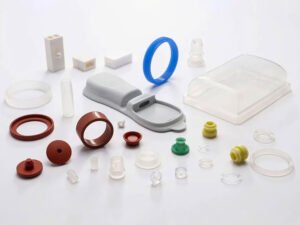Silicone rubber has countless applications in diverse fields and industries. You can get them in two main formulations: Solid Silicone(HTV) and Liquid Silicone(LSR). Both have a wide array of use-cases, but what exactly is the difference between the two? Which one should you choose for your particular application?
As you know, both of these resulting products can be hard to distinguish from one another. So in this article, we’ll be laying down their differences to help you decide which one is suitable for your application.
1. Solid Silicone And Liquid Silicone Materials: What’s the Difference?
Silicone rubber is a high-efficiency, synthetic elastomer used in various applications.
You can cast them in different complex shapes and sizes. Both variants also achieve various environmental applications. It’s no wonder since silicone is widely considered sustainable and eco-friendly. Because of their flexibility, solid and liquid silicone rubbers produce innumerable end products.






In terms of size, both variants have minimal differences. It also has almost no distinction when it comes to visuals and how it feels to the touch.
So are there actually any noteworthy differences between the two? Well, there’s one significant distinction. And that lies in the processing technologies used for both materials. Let’s look at the two variants in more detail.
HTV Silicone - Solid Silicone Rubber
As the name suggests, solid silicone rubber is, well, solid. It comes from the solidified silicone raw material. To process this silicone type, manufacturers must soften it through heating. They’ll use a roller for this function until the raw material is hot enough to ease into an elastic mold.
![]()
The stretchable mold must go through a vulcanizer and undergo pressing at a high temperature. This stage is when the manufacturers achieve their desired hardness.
Solid silicone rubber has extensive applications. You’ll see it used a lot in various industries, like construction, aviation, and consumer products, to name a few. It has many desirable properties, so industries are more than happy to use them. Here are some of its most notable characteristics:
- High-temperature resistant
- Low-temperature resistant
- Chemical & solvent-resistant
- Excellent electrical insulation
- Non-stick properties
Solid silicone rubber uses compression molding, which is cheaper than injection molding. For this reason, solid silicone molds typically cost less than their liquid counterparts. The processing also offers a lot of variety. You can generate different parts for a variety of uses.
The processing technology used, however, has one main drawback. It runs on manual operation and only reaches a certain amount of softness.
LSR Silicone - Liquid Silicone Rubber
Liquid silicone rubbers are glue-like, platinum-cured silicone elastomers. They’re mainly processed through liquid injection molding (LIM). Like solid silicone, liquid silicone also goes through high-temperature vulcanization. During processing, a machine will inject heated raw materials into the mold.
![]() Its production has a quick cycle time and can be fully automated. There’s also less need to deal with many raw materials. Thanks to these factors, it has a faster processing turnaround and doesn’t involve too much manual labor.
Its production has a quick cycle time and can be fully automated. There’s also less need to deal with many raw materials. Thanks to these factors, it has a faster processing turnaround and doesn’t involve too much manual labor.
Liquid silicone also has different notable properties that make it desirable for use in many industries. It’s widely used in healthcare, automotive, and even product and food packaging. Here are some of its advantageous properties:
- Fast vulcanization
- Excellent fluidity
- Environmentally safer
- Can comply fully with food-grade requirements
- Mostly non-irritant to the skin
Many skin-care products use liquid silicone. It’s even safe to use for infants and medical care. As mentioned, its processing is fast and convenient, but there’s one drawback. The injection molding method costs higher, ultimately bleeding down to the cost of every end product.
2. How to Distinguish Between Liquid Silicone and Solid Silicone?
It’s clear that the production process used is the main difference between these two silicone types. But there are other ways that you can distinguish between the two. Let’s go through them.
Functions in Industry
Solid silicone is generally used in everyday consumer products. You can also find it on various industrial and mechanical parts, like those used in aviation and automotive.
Liquid silicone, on the other hand, finds much more use in healthcare and food products. These variants are used for applications that need contact with the human skin.
Safety
Safety is always a concern when it comes to synthetic materials. Thankfully, both silicone rubber types are environmentally friendly and safe for human contact. Both also have transparency, even though they differ in the applied manufacturing process.
Appearance
In terms of visuals, liquid silicone appears denser since it’s in a liquid state. It also has a higher fluidity and will flow more freely. Meanwhile, solid silicone will not be so fluid since it leans towards solidity.
Storage
Manufacturers must store both types of silicone in enclosed containers under cool temperatures. Storage temperature ranges from 0 to 30 °C.
For liquid silica, however, exposure to higher temperatures may diminish shelf life.
End Products
The biggest difference between the two types when it comes to end products is transparency and odor. Solid silicone finishes often have lower transparency compared to liquid silicone products.
Solid silicone also emits an odor, which comes from its vulcanizing agent. In contrast, liquid silicone is essentially odorless.
3. Which One Should You Get for Your Application?
Specific applications prefer their own type of silicone rubber. For example, skincare and medical applications require more skin-friendly liquid silicone. However, for daily consumer product, manufacturers will turn to solid silicone.
Because of the diversity of silicon rubber products, when choosing Liquid Silicone or Solid Silicone, you also need to select the silicone raw materials with different characteristics according to the requirements of the finished product, such as:
- Transparency
- Tear resistance
- Resilience
- High-temperature resistance
- Electrical conductivity
- Insulation performance
Also worth considering is the amount and amount of silicone you need. If you have larger production requirements, you may want to use injection molded LSR to get a faster turnaround time. If you have a small volume requirement, it is best to choose a cheaper molding.
Work With One of the Best Silicone Rubber Material Manufacturers in China.
GX silicone![]() can provide you with the best solutions, whichever method you choose. Enjoy fast production times and cost savings. The best part? You get high-quality and dependable silicone raw materials for your application.
can provide you with the best solutions, whichever method you choose. Enjoy fast production times and cost savings. The best part? You get high-quality and dependable silicone raw materials for your application.
At GX Silicone, we’re committed to providing exceptional silicone rubber. Since our inception in 2007, we’ve always held ourselves to the highest standard to provide you with unparalleled service and unrivaled product quality.